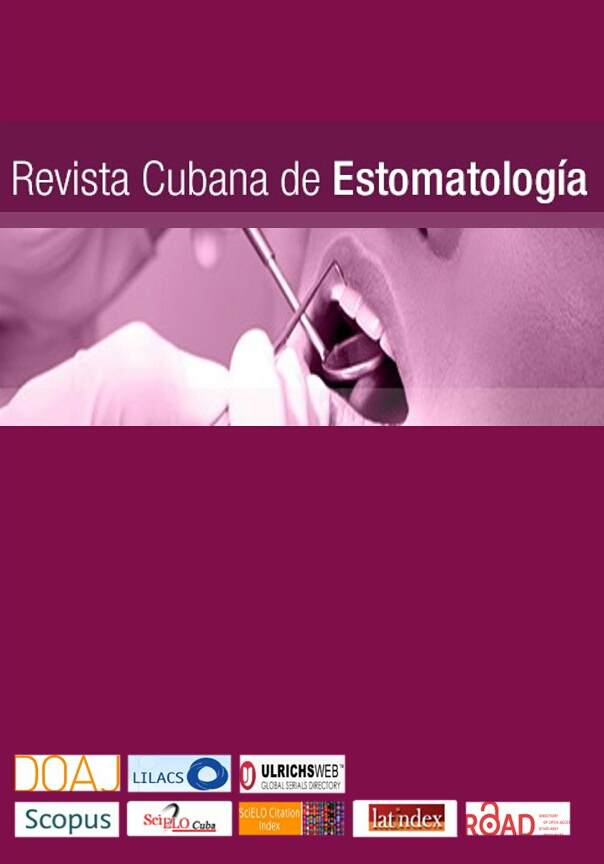Salivary biomarkers for the diagnosis and monitoring of oral and systemic diseases
Keywords:
saliva, biomarkers, diagnosis.Abstract
Introduction: Human saliva consists of a vast arsenal of secretory products with huge information potential useful for the detection of certain diseases. The easy availability and the specificity of biomarkers make them an important clinical tool as a diagnostic method.
Objective: By means of a bibliographic review, verify the use of saliva as a diagnostic method for oral and systemic diseases.
Methods: A bibliographic search was conducted in the online database PubMed for papers published in English from 2013 to September 2018, using the search terms "saliva", "biomarkers" and "diagnosis". Papers written in English in the last five years were selected. Of the 245 papers obtained, the study considered 17.
Data analysis and integration: It was found that saliva may be used as a diagnostic method for a variety of diseases. These include bacterial diseases such as dental caries, by detection of Streptococcus mutans and Lactobacillus spp.; autoimmune diseases such as Sjögren's syndrome, indicated not only by the decrease in salivary flow, but also by the increase in the concentration of sodium, chlorine, immunoglobulin A (IgA), immunoglobulin G (IgG), and prostaglandin E2 (PGE2); viral diseases as in the auxiliary diagnosis of HIV 1 and 2 by IgG expression and also in the early diagnosis of malignant diseases such as squamous cell carcinoma and breast cancer by detection of antibodies against p53 protein and the presence of tumor markers such as c-erbB-2.
Conclusions: Molecular diagnostic examination of the oral cavity using saliva has shown to be a simple, non-invasive and very promising method for the diagnosis and monitoring of numberless diseases.Downloads
References
Lima DP, Correia ASC, Anjos AL, Boer NP. O uso de saliva para diagnóstico de doenças orais e sistêmicas. Rev Odontol Araçatuba. 2014;35(1):55-9.
Liu J, Dua Y. Saliva: a potential media for disease giagnostics and monitoring. Oral Oncol. 2012;48(7):569-77.
Yoshizawa JM, Schafer CA, Schafer JJ, Farrell JJ, Paster BJ, Wong DTW. Salivary Biomarkers: Toward Future Clinical and Diagnostic Utilities. Clin Microbiol Rev. 2013 Oct;26(4):781-91.
Cuevas-Córdoba B, Santiago-García J. Saliva: a fluid of study for OMICS. J Int Biol. 2014 Feb;18(2):87-97.
Fuentes L, Yakob M, Wong DTW. Emerging horizons of salivary diagnostics for periodontal disease. Br Dent J. 2014 Nov;217(10):567-73.
Majem B, Rigau M, Reventós J, Wong DT. Non-Coding RNAs in Saliva: Emerging Biomarkers for Molecular Diagnostics. Int J Mol Sci. 2015 Apr;16(4):8676-98.
Nunes LAS, Mussavira S, Bindhu OS. Clinical and diagnostic utility of saliva as a non-invasive diagnostic fluid: a systematic review. Biochem Med. 2015 Jun;25(2):177-92.
Güncü GN, Yilmaz D, Kononemn E, Gursoy UK. Salivary Antimicrobial Peptides in Early Detection of Periodontitis. Front Cell Infect Microbiol. 2015 Dec 24;5-99.
Podzimek S, Vondrackova L, Duskova J, Janatova T, Brouka Z. Salivary Markers for Periodontal and General Diseases. Hindawi Publishing Corporation. Disease Markers. 2015;2(1):1-8.
Zhang Y, Sun J, Lin CC, Abremayor E, Wang MB, Wong DT. The emerging landscape of salivary diagnostics. Periodontol 2000. 2016 Feb;70(1):38-52.
Prasad S, Tyagi AK, Aggarwal BB. Detection of inflammatory biomarkers in saliva and urine: Potential in diagnosis, prevention, and treatment for chronic diseases. Exp Biol Med. 2016 Apr;241(8):783-99.
Mikkonen JJW, Singh SP, Herrala M, Lappalainen R, Myllymaa S, Kullaa AM, et al. Salivary metabolomics in the diagnosis of oral cancer and periodontal diseases. J Periodont Res. 2016 Aug;51(4):431-7.
Rapado-González O, Majem B, Muinelo-Romay L, López-López R, Suarez-Cunqueiro MM. Cancer Salivary Biomarkers for Tumours Distant to the Oral Cavity. Int J Mol Sci. 2016 Sep;17(9):1-18.
Zhang CZ, Cheng XQ, Li JY, Zhang P, Xu X, Zhou XD. Saliva in the diagnosis of diseases. Int J Oral Sci. 2016 Sep;29(8):133-7.
Tasoulas J, Patsouris E, Giaginis C, Theocharis S. Salivaomics for oral diseases biomarkers detection. Expert Rev Mol Diagn. 2016;16(3):285-95.
Wang X, Kaczor-Urbanowicz KE, Wong DTW. Salivary biomarkers in cancer detection. Med Oncol. 2017 Jan;34(1):1-12.
Kaczor-Urbanowicz KE, Carrera-Presas CM, Aro K, Tu M, Garcia-Godo F, Wong DTW. Saliva diagnostics – Current views and directions. Exp Biol Med (Maywood). 2017 Mar;242(5):459-72.
Stuani VT, Rubira CMF, Sant’Ana ACP, Santos PSS. Salivary biomarkers as tools for oral squamous cell carcinoma diagnosis: A systematic review. Head Neck. 2017 Apr;39(4):797-811.
Humberto JSM, Pavanin JV, Rocha MJA, Motta ACF. Cytokines, cortisol, and nitric oxide as salivary biomarkers in oral lichen planus: a systematic review. Braz Oral Res. 2018 Mar;32(82):1-11.
Korte DL, Kinney J. Personalized medicine: an update of salivary biomarkers for periodontal diseases. Periodontol 2000. 2016 Feb;70(1):26-37.
Wilkinson E. Earlier cancer diagnosis would reduce NHS costs. Lancet Oncol. 2014;15(1):529.
Published
How to Cite
Issue
Section
License
Authors retain all rights to their works, which they can reproduce and distribute as long as they cite the primary source of publication.
The Rev Cubana Estomatol is subject to the Creative Commons Attribution-Non-Commercial 4.0 International License (CC BY-NC 4.0) and follows the publication model of SciELO Publishing Schema (SciELO PS) for publication in XML format.
You are free to:
- Share — copy and redistribute the material in any medium or format.
- Adapt — remix, transform, and build upon the material.
The licensor cannot revoke these freedoms as long as you follow the license terms.
Under the following terms:
Attribution — You must give appropriate credit, provide a link to the license, and indicate if changes were made. You may do so in any reasonable manner, but not in any way that suggests the licensor endorses you or your use.
- NonCommercial — You may not use the material for commercial purposes.
No additional restrictions — You may not apply legal terms or technological measures that legally restrict others from doing anything the license permits.
Notices:
- You do not have to comply with the license for elements of the material in the public domain or where your use is permitted by an applicable exception or limitation.
- No warranties are given. The license may not give you all of the permissions necessary for your intended use. For example, other rights such as publicity, privacy, or moral rights may limit how you use the material.


